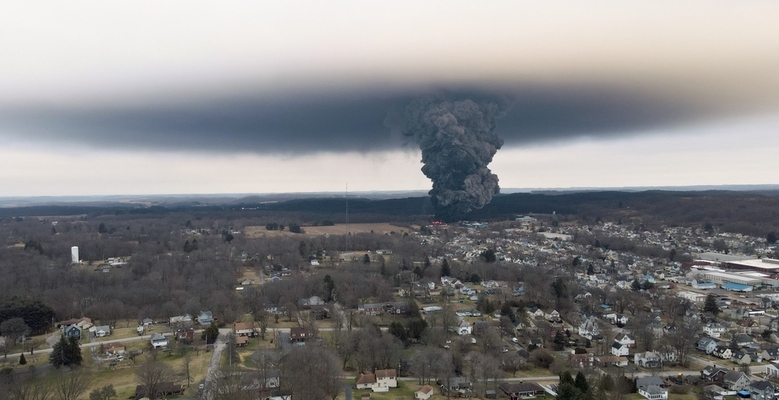The train derailment in northeast Ohio has sparked health concerns from the public as fish and farm animals near the scene are reportedly dying from the toxic chemicals in the air and water.
The train derailed on Feb. 3 and was carrying many chemicals including vinyl chloride, which is a toxic gas used to make plastics, adhesives, and other chemicals. In total, 38 rail cars derailed and an additional 12 cars were damaged by a fire. Half of the 20 hazardous material cars in the train derailed.
A coordinated decision to burn the chemicals was made by local, state, and federal officials along with scientists. One of the byproducts of burning vinyl chloride, however, is hydrogen chloride. Hydrogen chloride latches onto water in the atmosphere and can turn into hydrochloric acid, seriously contaminating the air and water.
Many concerned people are sounding the alarm on the possible effects, especially as the toxins move east with weather patterns.
"Right now government officials, officials from the railroad, both the Governor of Pennsylvania and Ohio are calling burning off the million pounds of this stuff a success, but not mentioning that it means that we have hundreds of thousands of pounds of acid in the air potentially," described an expert in a video circulating the internet.
Secretary of Transportation Pete Buttigieg addressed the derailment and its impacts on "hundreds of residents." However, the damage being done could have far more extensive impacts on human health than what government officials are admitting.
Ohio Governor Mike DeWine's office said that no reports have been received by the Ohio Department of Health, according to The Center Square. Any effects reported to doctors are required to be reported to the state within 24 hours.
"We have monitoring systems in place. We are aware of those reports but have not seen any reports from health officials yet. Given the levels we’ve seen, we would not expect to,” said a DeWine spokesperson.
But not all the consequences from human exposure are instantaneous like in fish. The effects of high exposure to carcinogens would likely be experienced years down the road long after the emergency subsides.
Local utilities, independent contractors, Environmental Protection Agency staff and Ohio officials are all monitoring air and water quality, which reportedly remain within acceptable levels.
In today's age, are government standards really the best way to prove what is acceptable to human health? The burning chemicals are clearly affecting people in rural Ohio towns. Residents say they can smell the chlorine in the air and are experiencing burning eyes. Many miles away, chickens are reportedly dying and hundreds of fish have been found dead in rivers.
One woman told the Washington Post, "I’ve watched every news conference and I haven’t heard anything that makes me think that this is a data-driven decision. We don’t feel like we have a whole lot of information."
The biggest vinyl chloride spill prior to this event was in 2012 in New Jersey. One train car spilled 23,000 gallons of the chemical, but it didn't catch on fire.
This is a major health concern and officials don't appear fully upfront in warning the public of the vast hazards of burning toxins. While the government tells us it's safe, let's remember how many things the government has insisted we do for 'health' in the past three years alone.
Join the Convention of States movement in reining in the federal government. Please sign the petition below.






